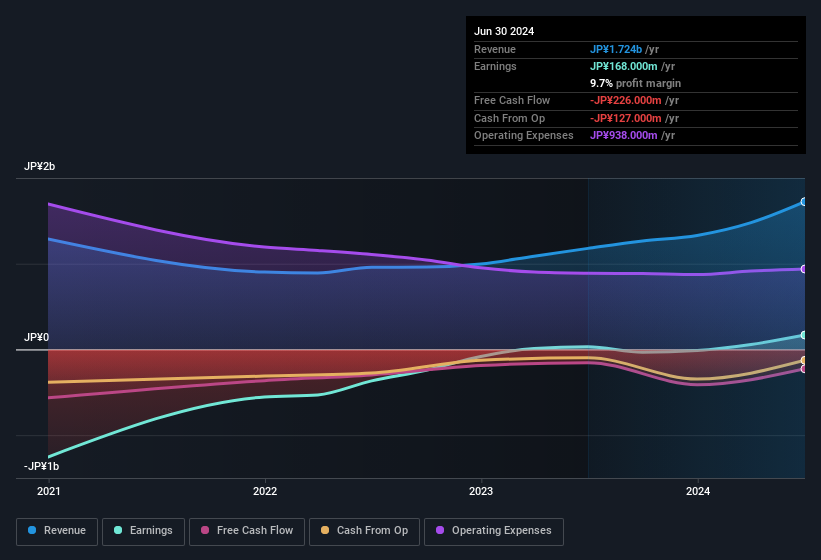- Japan
- /
- Industrials
- /
- TSE:9271
We Believe Wagokoro's (TSE:9271) Earnings Are A Poor Guide For Its Profitability

Strong earnings weren't enough to please Wagokoro Co., Ltd.'s (TSE:9271) shareholders over the last week. Our analysis found several concerning factors in the earnings report beyond the strong statutory profit number.
See our latest analysis for Wagokoro

Zooming In On Wagokoro's Earnings
As finance nerds would already know, the accrual ratio from cashflow is a key measure for assessing how well a company's free cash flow (FCF) matches its profit. The accrual ratio subtracts the FCF from the profit for a given period, and divides the result by the average operating assets of the company over that time. This ratio tells us how much of a company's profit is not backed by free cashflow.
That means a negative accrual ratio is a good thing, because it shows that the company is bringing in more free cash flow than its profit would suggest. While it's not a problem to have a positive accrual ratio, indicating a certain level of non-cash profits, a high accrual ratio is arguably a bad thing, because it indicates paper profits are not matched by cash flow. That's because some academic studies have suggested that high accruals ratios tend to lead to lower profit or less profit growth.
Over the twelve months to June 2024, Wagokoro recorded an accrual ratio of 1.10. As a general rule, that bodes poorly for future profitability. To wit, the company did not generate one whit of free cashflow in that time. Even though it reported a profit of JP¥168.0m, a look at free cash flow indicates it actually burnt through JP¥226m in the last year. Coming off the back of negative free cash flow last year, we imagine some shareholders might wonder if its cash burn of JP¥226m, this year, indicates high risk. Having said that, there is more to the story. The accrual ratio is reflecting the impact of unusual items on statutory profit, at least in part.
Note: we always recommend investors check balance sheet strength. Click here to be taken to our balance sheet analysis of Wagokoro.
The Impact Of Unusual Items On Profit
Given the accrual ratio, it's not overly surprising that Wagokoro's profit was boosted by unusual items worth JP¥32m in the last twelve months. While we like to see profit increases, we tend to be a little more cautious when unusual items have made a big contribution. We ran the numbers on most publicly listed companies worldwide, and it's very common for unusual items to be once-off in nature. And, after all, that's exactly what the accounting terminology implies. If Wagokoro doesn't see that contribution repeat, then all else being equal we'd expect its profit to drop over the current year.
Our Take On Wagokoro's Profit Performance
Summing up, Wagokoro received a nice boost to profit from unusual items, but could not match its paper profit with free cash flow. Considering all this we'd argue Wagokoro's profits probably give an overly generous impression of its sustainable level of profitability. If you'd like to know more about Wagokoro as a business, it's important to be aware of any risks it's facing. For instance, we've identified 5 warning signs for Wagokoro (3 are a bit concerning) you should be familiar with.
Our examination of Wagokoro has focussed on certain factors that can make its earnings look better than they are. And, on that basis, we are somewhat skeptical. But there are plenty of other ways to inform your opinion of a company. For example, many people consider a high return on equity as an indication of favorable business economics, while others like to 'follow the money' and search out stocks that insiders are buying. While it might take a little research on your behalf, you may find this free collection of companies boasting high return on equity, or this list of stocks with significant insider holdings to be useful.
Valuation is complex, but we're here to simplify it.
Discover if Wagokoro might be undervalued or overvalued with our detailed analysis, featuring fair value estimates, potential risks, dividends, insider trades, and its financial condition.
Access Free AnalysisHave feedback on this article? Concerned about the content? Get in touch with us directly. Alternatively, email editorial-team (at) simplywallst.com.
This article by Simply Wall St is general in nature. We provide commentary based on historical data and analyst forecasts only using an unbiased methodology and our articles are not intended to be financial advice. It does not constitute a recommendation to buy or sell any stock, and does not take account of your objectives, or your financial situation. We aim to bring you long-term focused analysis driven by fundamental data. Note that our analysis may not factor in the latest price-sensitive company announcements or qualitative material. Simply Wall St has no position in any stocks mentioned.
About TSE:9271
Proven track record with mediocre balance sheet.
Market Insights
Community Narratives



